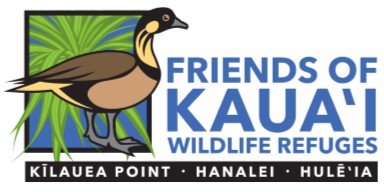Wildlife Spotlight: ʻAʻo
One of the endangered seabirds that Kīlauea Point NWR was founded to protect is the ʻaʻo, or Newell's Shearwaters. They are small endangered seabirds that are endemic to Hawaiʻi, meaning that they are found only here. 90 percent of the remaining population nests on Kauaʻi, with smaller colonies found on Molokaʻi, Maui, and Hawaiʻi Island.
ʻAʻo have black plumage above and white below, along with a long tail and long, thin bill. The white on the belly extends up onto the flanks, which forms a distinctive white spot behind each wing. 'A'o have a distinctive low, moaning call, typically heard just after sunset, which is described as a braying donkey and gives them their Hawaiian name.
While their more plentiful “cousin,” the ʻuaʻu kani or Wedge-tailed Shearwaters, nest in coastal burrows, ʻaʻo nest in burrows on steep slopes and cliffs in the mountains. They are an important part of our island ecosystem and help to fertilize our native forests with their rich guano, as they travel to and from their mountain burrows at dusk to care for their eggs and young.
ʻAʻo lay just one egg per season, which runs from April to early November, when the fledglings will leave their burrows and fly out to sea under the night sky. They will then spend the next three to four years at sea before navigating back to their original hatch site using the stars and geographical surroundings to guide them. ʻAʻo forage over the open ocean, can dive to depths of over 150 feet in pursuit of schooling fish and squid, and can live up to 40 years.
ʻAʻo were thought to be extinct at the beginning of the 20th century but were rediscovered in 1947, and their status remains precarious. They were listed as threatened under the Endangered Species Act in 1975 because of catastrophic population declines they have experienced.
The threats to this species are extensive. Hurricanes have severely impacted many of the forests where they breed, and invasive plants and animals such as pigs and goats have further degraded these habitats. Predation at nest burrows by rats, mongoose and free-roaming cats is another significant threat. It is estimated that there are 25,000 feral cats on Kauaʻi and they continue to pose a significant to risk all of our ground-nesting seabirds and waterbirds.
Light pollution is also a significant threat. Young birds heading to sea for the first time are attracted by the artificial lighting of playing fields, hotels, resorts, and homes. They become disoriented and circle the lights until they become exhausted and fall to the ground, where they may be injured or killed by cars, cats and dogs, or suffer starvation and dehydration. Sadly, collisions with power lines also kill many ‘aʻo as they travel to and from nest burrows.
Save Our Shearwaters (SOS) was founded in 1979 to provide care and rehabilitation for sick, injured and downed birds. With the support of our community, Friends of Kauaʻi Wildlife Refuges is honored to be able to provide annual funding for the cost of care for birds transferred from one of our three refuges into the care of SOS.
In addition, the Nihokū Ecosystem Restoration Project was created in 2012 to provide a predator-free nesting area for native ground-nesting birds. The project is a result of a multi-year partnership between multiple government and non-profit groups including the U.S. Fish and Wildlife Service, Pacific Rim Conservation and the Kauaʻi Endangered Seabird Recovery Project to create a safe nesting site within a predator-proof enclosure on Nihokū, a portion of Kīlauea Point NWR located been the Kīlauea Road Overlook and Mokolea Point.
‘A‘o and ‘ua‘u (Hawaiian Petrels), Hawai`i’s only two endemic seabirds, were translocated to the site over several years, beginning in late 2015. The goal was to create new colonies that are safe from non-native terrestrial predators. We wait with great anticipation for the first nesters to return and begin to establish a new colony. To learn more about the project, please visit www.nihoku.org.
To help our ‘aʻo, please keep cats indoors, use only downward facing exterior lighting, turn all outdoor lights off from October through November, and, if you find a downed bird, please take it to an SOS aide station near you. It takes a colony...

